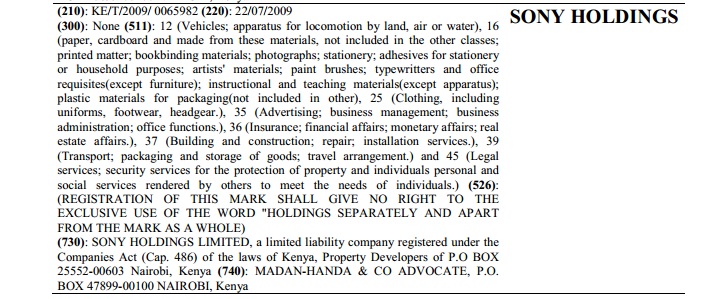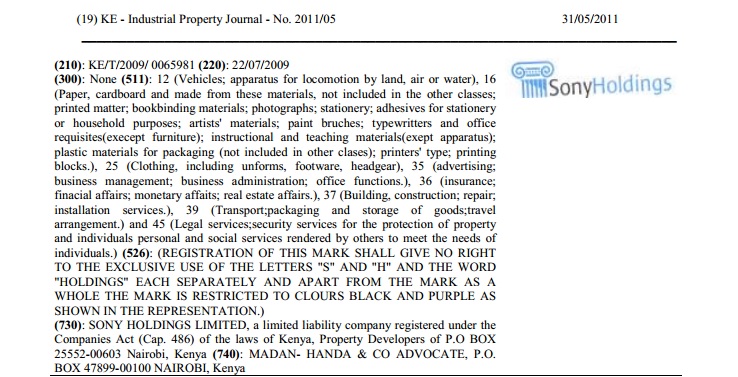Sony Holdings Ltd v. Sony Corporation: Unfettered Discretion of the Registrar of Trade Marks to Extend Time?
- Victor Nzomo |
- April 11, 2014 |
- CIPIT Insights,
- Intellectual Property,
- Trademark
We think it is arguable whether, under rule 102 of the Trademarks Rules, the Registrar has unfettered discretion to extend time. – Court of Appeal at Nairobi.
The case of the Republic Ex-Parte Sony Holdings Limited v Registrar of Trade Marks & another [2014] eKLR (the “Sony case”) becomes one of a handful of intellectual property (IP) related cases to find its way to the Court of Appeal. It is an important case as it invites the judicial arm of government to determine whether executive arm of government, through the Registrar of Trade Marks has acted outside the law in exercising its statutory functions.
The Sony case arose way back in 2009 when Sony Holdings applied for the registration of two trademarks (a word mark, and a word device). Sony Holdings submitted the proposed trademarks for registration by way of two letters dated 18th May 2009. The Registrar of Trademarks wrote back to Sony Holdings on 8th September 2009, giving notice of refusal to register the trademarks. The Advocate’s wrote back to the Respondent asking that he reconsider his refusal. The Respondent then gave approvals for the marks to be advertised in the Industrial Property Journal. The advertisement was done on 31st May 2011 as appears above and below.

However, on 26th January 2012, the Registrar of Trade Marks wrote to Sony Holdings, informing the latter that an extension of time had been granted to Sony Corporation to lodge a notice of opposition. Sony Holdings wrote back to the Registrar of Trade Marks on 29th February 2012 indicating its objection to the extension of time. The Registrar did not respond to the content of this last letter and instead wrote to Sony Holdings informing it that a notice of opposition had been filed on behalf of Sony Corporation, and asked Sony Holdings to file a counter statement within 42 days.
Therefore Sony Holdings’ case before the High Court was that the Registrar’s exercise of discretion in extending time to file the notice of opposition was illegal, irregular and wrongful. Warsame J. sitting in the High Court dismissed Sony Holdings’ application and held that the Registrar had not exceeded its statutory authority in extending the time for filing the notice of opposition. In this judgment, the learned judge makes two important points relating to judicial review in intellectual property administration. First and foremost, the High Court dismisses the internal exhaustion rule in administrative law which would require that an aggrieved party exhausts all avenues of recourse available under the enabling statute before approaching the courts for a review. In the present case, the court disagreed and stated that:
I am of the view that the present application is properly before the court because the Applicant [Sony Holdings] has alleged that the Respondent [the Registrar] acted in excess of his jurisdiction. An action taken in excess of jurisdiction can only be quashed by way of judicial review orders.
The second important point made by the High Court relates to the principle of legitimate expectation. This principle states that if a public body leads a person to expect that the public body will, continue to act in a way then the latter should not, without an overriding reason in the public interest, resile from that representation and unilaterally cancel the expectation of the person that the state of affairs will continue. In other words, for a legitimate expectation to arise, there must be a promise or representation that arises from the public body, that would be reasonably expected to continue. In the present case, the court explained why Sony Holdings could not rely on the principle of legitimate expectations as follows:
The fact that the trademarks had been advertised did not necessarily mean that the trademarks would as of right be registered. In fact, there was no representation to the Applicant that these marks would definitely be registered once the advertisement in the journal had been done.
Recently the Court of Appeal heard and determined an application by Sony Holdings for an order that pending the hearing and determination of the it’s appeal from the judgment of the High Court that there be a stay of opposition proceedings pending before the Registrar of Trademarks or any action under the Trademarks Act by the Registrar.
Sony Holdings argued that the substance of the appeal is the legality of the opposition proceedings before the Registrar and if the proceedings continue to conclusion then the substance of the appeal would be lost. Sony Corporation in reply argued that Sony Holdings would have a right of appeal or review to the High Court on the merits of the opposition proceedings and for that reason there would be no prejudice to Sony Holdings should the opposition proceedings before the Registrar of Trade Marks proceed to conclusion.
The Court of Appeal rejected Sony Holdings’ application for stay stating that any party dissatisfied with the decision of the Registrar would have recourse to the Courts.
Meanwhile, the root cause of this dispute remains the wide discretion given to the Registrar under Rule 102 in matters of extension of time. How does one establish whether such discretion has been exercised unreasonably, in bad faith or in disregard to the law?
This blogger will be keenly following the developments around this case both before the Registrar and the Court of Appeal.


Evans
Evans